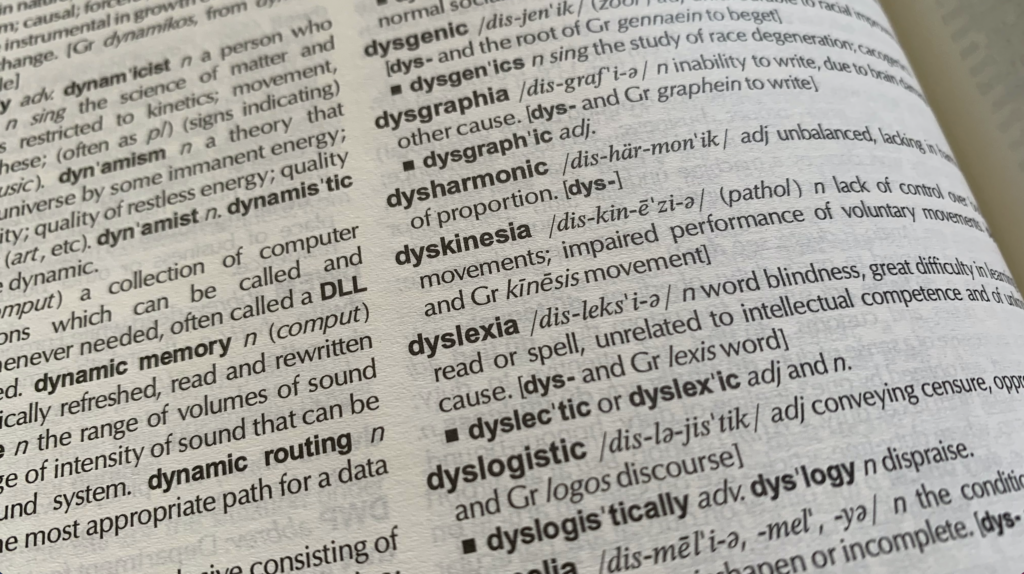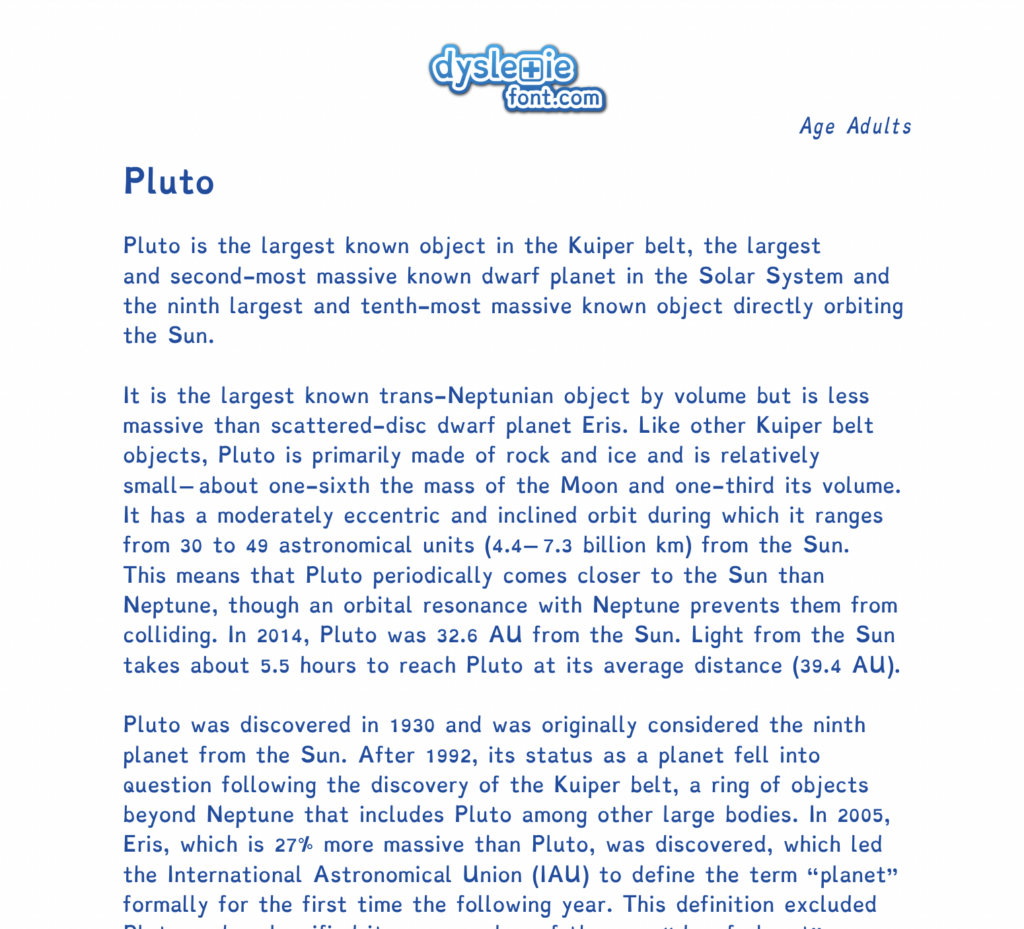
I feel like I have tried and tested almost every single piece of technology to aid with my learning disability. There are tried and true one’s that I will stick to forever. However, are there new technology programs being made or ones that have not been discovered yet?
I am always on the hunt for new technologies to aid my learning but most of them have a price.
I did some research for any new tech and Dyslexia Canada had some interesting suggestions for students to use on their computers. One of the computer programs that stood out to me the most was Dyslexie Font.
What is Dyslexie Font?
At the first glance, I was a little bit suspicious about Dyslexie Font which is suppose to be a font that is easier for dyslexic people to read. It is an extension for your computer so you can use your web browser with the font or type with it. The program is free however, if you want it for a school institution or a better version for yourself, it ranges from $80-$150 for “a lifetimes worth” (Dyslexie Font – An award winning Dyslexia font).
Additionally, “Dyslexia fonts use thicker lines in parts of letters. The letters are slanted a bit. And letters that have sticks and tails (b, d,and p) vary in length. Some people with dyslexia like this and find it helpful” (Do dyslexia fonts help?).
According to Understood “Researchers have studied these typefaces. So far, they haven’t found evidence that the fonts help kids or adults read faster and with fewer mistakes”(Do dyslexia fonts help?). It is interesting that Dyslexia Canada recommended this even though there are no real improvements in reading.

Source Dyslexie: “Dyslexie Font Example Page Adults.” Dyslexie Font, PINGONLINE, https://dyslexiefont.com/public/media-upload/PDF%20Bestanden/Dyslexie-font-example-page%20adults.pdf?_ga=2.206826641.348597750.1664925212-505056238.1664925212.
Does It Actually Work?
I decided to try this out for myself and see if it was actually helpful with my reading. Dyslexie Font has a test text for users to test out the font. I read a page about Pluto with the text (see above image) andI did not read any better than I usually do. I personally like larger text to read and with large spacing. I would suggest for people just to change the font size on their computer or just to zoom in on the page.
I did even further research into this company. I read reviews online and apparently according to users, it distorts websites with the font, which is a big negative. However, some people love the font, it just depends on the person.
Suspicions of the Company:
I started to become quite suspicious of Dyslexie so I decided to watch the founders Ted Talk from 2011. First off, what made me mad in his presentation is he said that there are “some jobs, you can’t do if you have dyslexia” (TEDxTalks). The founder is dyslexic himself and the fact he iss making this completely false statement about dyslexic people is very harmful. There are some struggles that people with dyslexia may face in the workforce but his statement completely diminishes people with dyslexia and their abilities. There are some other issues I have with his presentation which overall just perpetrate stereotypes on dyslexic people. The general narrative of his presentation is if you use his software, it will make your dyslexia better. Also he was suggesting that dyslexic people struggle more with visuals but “dyslexia is an issue with language, not vision” (Terada). The founder does not sound very fact based and more about selling a product.
I personally think this computer program just commodifies dyslexia for a profit with no real research to back it up. According to Edutopia, “Children with dyslexia do not read better when text is printed in the font Dyslexie than when text is printed in Arial or Times New Roman”(Terada). It may even “give students false hope—and result in disappointment […] ‘The most harm may come when students who have already experienced significant struggle and academic failures related to learning to read have yet another experience with failure when they are not able to read significantly better in a font designed to do so,’ they caution” (Terada).
Final Thoughts:
Overall, save your money and time and do not invest in dyslexic fonts. The British Dyslexic Association “[recommends] fonts designed for general legibility, like Arial, Verdana, and Tahoma. For better reading outcomes, font size should be between 12 and 14 points, and section headings should be used to create a consistent structure within your documents, easing navigation and supporting better sense-making”(Terada). Furthermore, “Classroom accommodations such as audiobooks, note-taking apps, video recordings of assignment instructions, and text-to-speech software can help students with dyslexia feel supported and accepted” (Terada). That type of tech support is what I have had almost all throughout my education. It has always been a huge support for me. This does not mean though that there is new technology that is worth trying. I have a hope that there is new and better tech being made to help people with learning disabilities.
Works Cited:
“Do Dyslexia Fonts Help?” Understood, Understood for All, https://www.understood.org/en/articles/dyslexia-friendly-font.
“Dyslexia Friendly Reading Material.” Dyslexia Canada, Dyslexia Canada, https://www.dyslexiacanada.org/en/tools.
“A Dyslexia Typeface.” Dyslexie Font , PINGONLINE, https://www.dyslexiefont.com/en/typeface/.
“Dyslexie Font – An Award Winning Dyslexia Font.” Dyslexie Font, PINGONLINE, https://www.dyslexiefont.com/.
“Dyslexie Font Example Page Adults.” Dyslexie Font, PINGONLINE, https://dyslexiefont.com/public/media-upload/PDF%20Bestanden/Dyslexie-font-example-page%20adults.pdf?_ga=2.206826641.348597750.1664925212-505056238.1664925212.
TEDxTalks, director. TEDxDubai 2011 | Christian Boer | How a Typeface Can Help People. YouTube, YouTube, 24 Nov. 2011, https://www.youtube.com/watch?v=-gqus1wEbmA. Accessed 5 Oct. 2022.
Terada, Youki. “Do Dyslexia Fonts Actually Work?” Edutopia, George Lucas Educational Foundation, 24 June 2022, https://www.edutopia.org/article/do-dyslexia-fonts-actually-work.
Hi Emily,
Wow this post really took me on a rollercoaster ride. I struggle with reading (in the process of being tested for a diagnosis) and language comprehension myself and am always interested in finding new tools of support. At first I was so interested by this idea of using a different font to support reading for those with dyslexia! I felt as though it could have some potential (even got my hopes up a bit) but upon reading the piece you provided, I found this text actually made it more difficult for me to read. In that moment I felt a smig of frustration with myself (similar to what you mentioned in your post with students).
But man! That bit about the TedXTalk! What awful limitations to put on people with a diagnosis of any kind! It really generalizes a whole group of people with very different strengths and weaknesses. I was quite fired up about that.
This is a fantastic post and very well researched! Would you ever consider continuing your education beyond a BEd to study various technologies to aid learning disabilities or creating your own in a masters or PhD program?